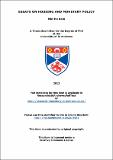Files in this item
Essays on housing and monetary policy
Item metadata
| dc.contributor.advisor | Mitra, Kaushik | |
| dc.contributor.author | Nam, Min-Ho | |
| dc.coverage.spatial | 213 | en_US |
| dc.date.accessioned | 2013-06-13T09:03:20Z | |
| dc.date.available | 2013-06-13T09:03:20Z | |
| dc.date.issued | 2013-03-19 | |
| dc.identifier.uri | https://hdl.handle.net/10023/3681 | |
| dc.description.abstract | This thesis, motivated by my reflections about the failings of monetary policy implementation as a cause of the sub-prime crisis, attempts to answer the following inquiries: (i) whether interest rates have played a major role in generating the house price fluctuations in the U.S., (ii) what are the effects of accommodative monetary policy on the economy given banks' excessive risk-taking, and (iii) whether an optimal monetary policy rule can be found for curbing credit-driven economic volatilities in the model economy with unconventional transmission channels operating. By using a decomposition technique and regression analysis, it can be shown that short-term interest rates exert the most potent influence on the evolution of the volatile components of housing prices. One possible explanation for this is that low policy rates for a prolonged period tend to encourage bankers to take on more risk in lending. This transmission channel, labelled as the risk-taking channel, accounts for the gap to some extent between the forecast and the actual impact of monetary policy on the housing market and the overall economy. A looser monetary policy stance can also shift the preference of economic agents toward housing as theoretically and empirically corroborated in the context of choice between durable and nondurable goods. This transmission route is termed the preference channel. If these two channels are operative in the economy, policy makers need to react aggressively to rapid credit growth in order to stabilize the paths of housing prices and output. These findings provide meaningful implications for monetary policy implementation. First of all, central bankers should strive to identify in a timely fashion newly emerging and state-dependent transmission channels of monetary policy, and accurately assess the impact of policy decisions transmitted through these channels. Secondly, the intervention of central banks in the credit or housing market by adjusting policy rates can be optimal, relative to inaction, in circumstances where banks' risk-taking and the preference for housing are overly exuberant. | en_US |
| dc.language.iso | en | en_US |
| dc.publisher | University of St Andrews | |
| dc.rights | Creative Commons Attribution-NonCommercial-NoDerivs 3.0 Unported | |
| dc.rights.uri | http://creativecommons.org/licenses/by-nc-nd/3.0/ | |
| dc.subject | Housing cycle | en_US |
| dc.subject | Monetary policy | en_US |
| dc.subject | Interest rates | en_US |
| dc.subject | Expectation | en_US |
| dc.subject | Risk-taking channel | en_US |
| dc.subject | LTV ratio | en_US |
| dc.subject | Borrowing constraint | en_US |
| dc.subject | Housing preference | en_US |
| dc.subject | Credit-driven volatilities | en_US |
| dc.subject.lcc | HG1854.N2 | |
| dc.subject.lcsh | Housing--Prices | en_US |
| dc.subject.lcsh | Monetary policy | en_US |
| dc.subject.lcsh | Transmission mechanism (Monetary policy) | en_US |
| dc.title | Essays on housing and monetary policy | en_US |
| dc.type | Thesis | en_US |
| dc.contributor.sponsor | Scottish Institute for Research in Economics (SIRE) | en_US |
| dc.contributor.sponsor | Bank of Korea (BOK) | en_US |
| dc.type.qualificationlevel | Doctoral | en_US |
| dc.type.qualificationname | PhD Doctor of Philosophy | en_US |
| dc.publisher.institution | The University of St Andrews | en_US |
This item appears in the following Collection(s)
Except where otherwise noted within the work, this item's licence for re-use is described as Creative Commons Attribution-NonCommercial-NoDerivs 3.0 Unported
Items in the St Andrews Research Repository are protected by copyright, with all rights reserved, unless otherwise indicated.


